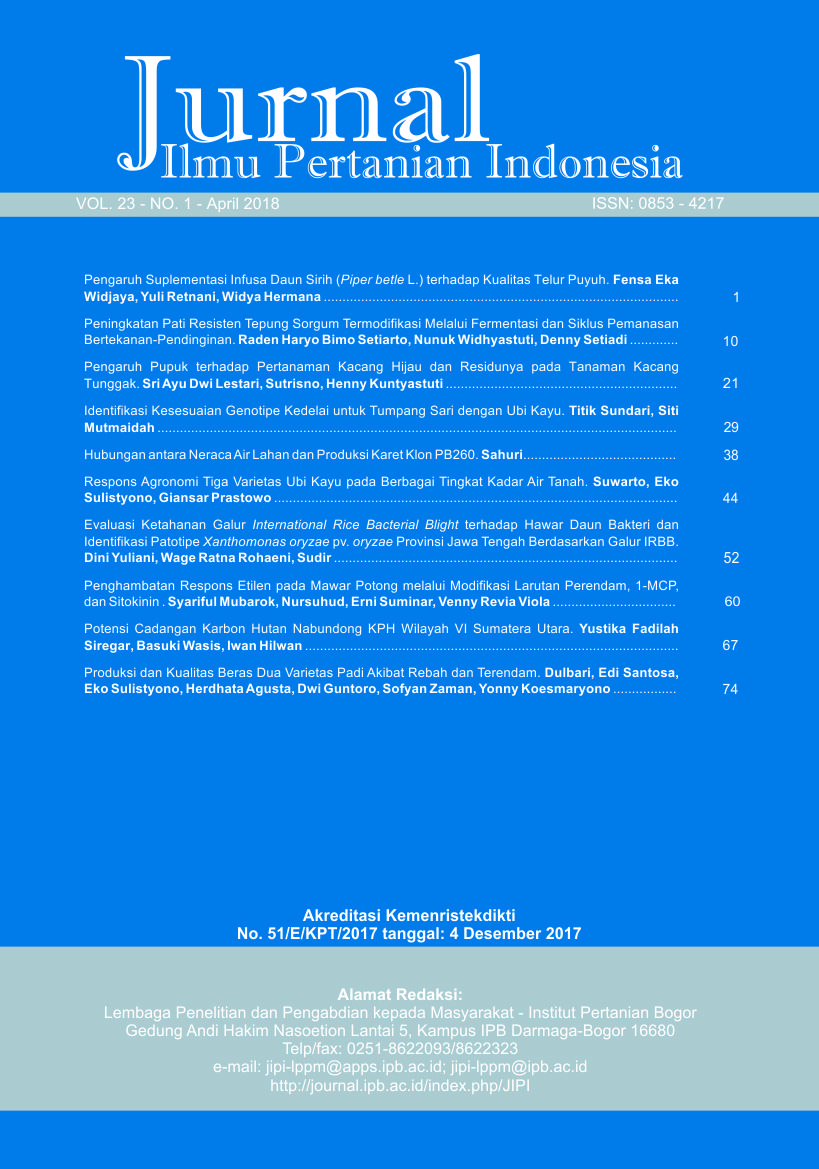Respons Agronomi Tiga Varietas Ubi Kayu pada Berbagai Tingkat Kadar Air Tanah
Abstract
Cassava has been cultivated in almost the all region of Indonesia as a raw material of food, feed, and industries. The productivity of cassava was varied among the region due to the variation of varieties used and growth environment, especially rainfall or water availability. Water deficit or drought stress will decrease the growth and yield of cassava. Selecting tolerant variety to drought will be important to get high productivity. An experimental pot in the greenhouse has been conducted to know the growth and yield response to drought. Three varieties of cassava i.e Adira-1, Gajah, and Mangu were planted in the pot at three level of soil moisture content (SMC) 40-60, 60-80, and 80-100% of field capacity (FC). The cassava growth traits were influenced by SMC starting at 6 weeks after planting (WAP) for a number of leaves, at 8 WAP for stem girth, at 10 WAP for plant height, at 14 WAP for lobus width, and 15 WAP for lobus length. Root, stem, and leaves dry weight in the SMC of 40-60% FC were 64.4; 43.98, and 31.19% of the dry weight in 80-00% FC. Roots yield in the soil moisture content of 40-60% FC decreased by 76.2% and in the SMC of 40-60%, FC decreased by 38.4% compared to in the SMC of 80-100% FC. The water use efficiency and roots yield of Gajah variety were highest.
Downloads
References
Aina OO, Dixon AG, Akinrinde EA. 2007. Effect of soil moisture stress on growth and yield of cassava in Nigeria. Pakistan Journal of Biological Science. 10(18): 3085-3090. http://doi.org/bmgc25
Alves AAC, Setter TL. 2000. Response of cassava to water deficit: leaf area growth and abscisic acid. Crop Science Society of America. 40(1): 131137. http://doi.org/cvb4bd
Alves AAC. 2002. Cassava: botany and physiology. In: Hillocks RJ, Thres JM, and Bellotti A, (Eds) Cassava: Biology, Production and Utilization. Wallingford (US): CABI Publishing. pp. 67-89. http://doi.org/crnxjc
[Balitkabi] Balai Penelitian Tanaman Aneka Kacang dan Umbi. 2017. Deskripsi varietas ubi kayu. Malang (ID): Badan Penelitian dan Pengembangan Pertanian. Kementerian Pertanian.
[BPS] Badan Pusat Statistik. 2017. Produktivitas Ubi Kayu Tahun 1993-2015. Jakarta (ID): Badan Pusat Statistik.
Blum A. 2009. Effective use of water (EUW) and not water-use efficiency (WUE) is the target of crop yield improvement under drought stress. Field Crops Research. 112(2009): 119-123. http://doi.org/dsxzvt
Darwati I, Rasita SMD, Hernani. 2002. Respon daun ungu (Graptophyllum pictum L.) terhadap cekaman air. Industrial Crop Research Journal. 8(3): 73-75.
Duque LO, Setter TL. 2013. Cassava response to water deficit in deep pots: root and shoot growth, ABA, and carbohydrate reserves in stems, leaves and storage roots. Tropical Plant Biology. 6(4): 199-209. http://doi.org/cmk3
Kurniasari AM, Adisyahputra, Rosman R. 2010. Pengaruh kekeringan pada tanah bergaram NaCl terhadap pertumbuhan tanaman nilam. Buletin Litro. 21(1): 18-27.
Lahai MT, Ekanayake IJ. 2009. Accumulation and distribution of dry matter in relation to root yield of cassava under a fluctuating water table in inland valley ecology. African Journal of Biotechnology. 8(19): 4895-4905.
Li J, Chang Z, Jiao F, Bai X, Zhang D, Zhai R. 2017. Influence of drought stress on photosynthetic characteristics and protective enzymes of potato at seedling stage. Journal of The Saudi Society of Agricultural Sciences. 16(1): 82-88. http://doi.org/cmk4
Odubanyo OO, Olufayo AA, Oguntunde PB. 2011. Water use, growth, and yield of drip irrigated cassava in a humid tropical environment. Soil and Water Res. 6: 10-20. http://doi.org/cmk5
Okogbenin E, Ekanayake IJ, Porto MCM. 2003. Genotypic variability in adaptation responses of selected clones of cassava to drought stress in the Sudan savanna zone of Nigeria. Journal Agronomi Crop Scince. 189: 376-389.
Okogbenin E, Setter TL, Ferguson M, Mutegi R, Cebalos H, Olasanmi B, Fregene M. 2013. Phenotypic approaches to drought in cassava: review. Article. Frontiers in Physiology Front. Plant Physiology. http://doi.org/bxb8m7
Rosadi RAB, Afandi, Senge M, Ito K, Adomako JT. 2007. The Effect of water deficit in typecal soil types on the yield and water requirement of soybean (Glycine max (L.) Merr.) in Indonesia. Japan Agricultural Research Quarterly (JARQ). 41(1): 47-52. http://doi.org/cmk6
This journal is published under the terms of the Creative Commons Attribution-NonCommercial 4.0 International License. Authors who publish with this journal agree to the following terms: Authors retain copyright and grant the journal right of first publication with the work simultaneously licensed under a Creative Commons Attribution-NonCommercial 4.0 International License. Attribution — You must give appropriate credit, provide a link to the license, and indicate if changes were made. You may do so in any reasonable manner, but not in any way that suggests the licensor endorses you or your use. NonCommercial — You may not use the material for commercial purposes.























